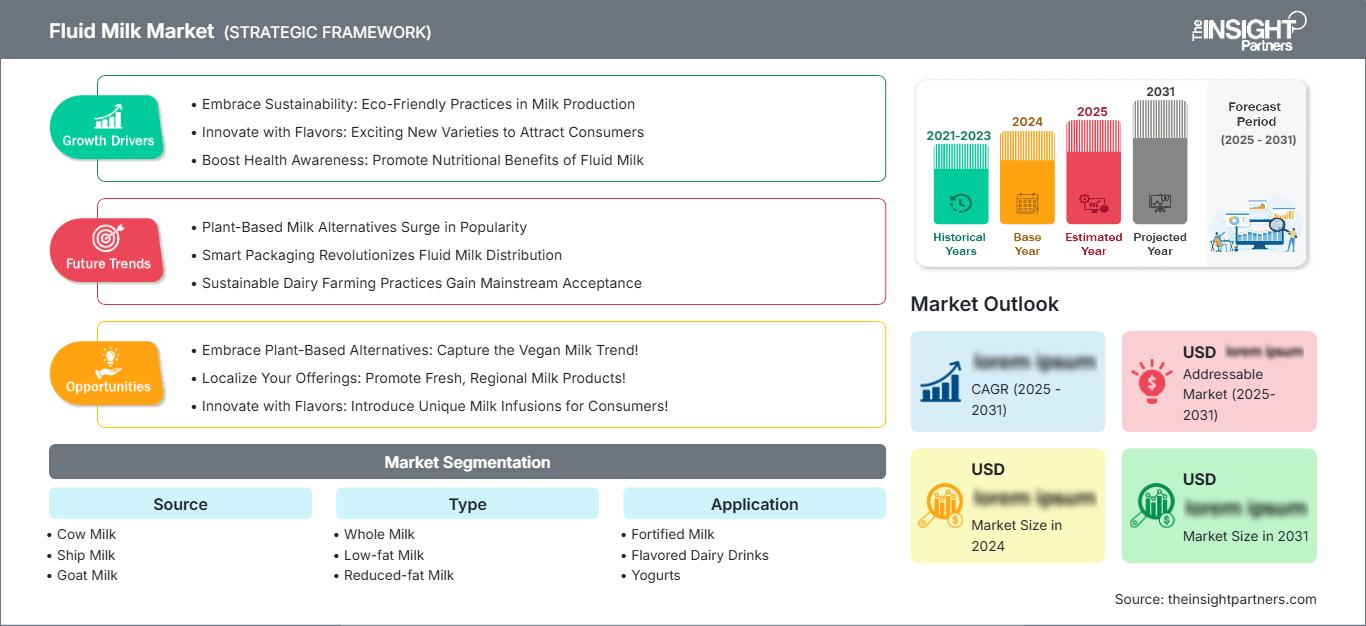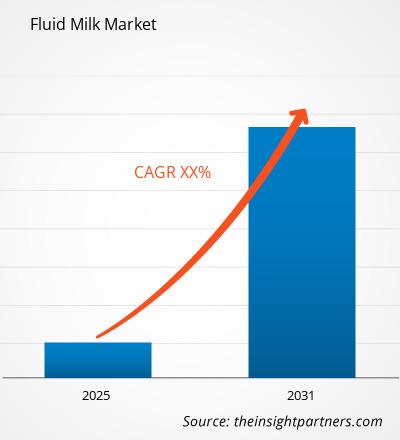Le marché du lait liquide devrait enregistrer un TCAC de XX % entre 2025 et 2031, avec une taille de marché passant de XX millions de dollars américains en 2024 à XX millions de dollars américains d'ici 2031.
Le rapport est classé par source (lait de vache, lait de bateau, lait de chèvre, lait de bufflonne) et analyse plus en détail le marché en fonction du type (lait entier, lait écrémé, lait écrémé, lait écrémé, babeurre de culture, lait sans lactose, lait aromatisé). Il examine également le marché par application (lait enrichi, boissons lactées aromatisées, yaourts, fromages, crèmes, desserts glacés) et par canal de distribution industriel (hypermarchés, supermarchés, magasins d'alimentation spécialisés, supérettes). Une ventilation complète est fournie aux niveaux mondial, régional et national pour chacun de ces segments clés. Le rapport comprend la taille du marché et les prévisions pour tous les segments, présentant les valeurs en USD. Français Il fournit également des statistiques clés sur l'état actuel du marché des principaux acteurs, ainsi que des informations sur les tendances actuelles du marché et les opportunités émergentes.
Objectif du rapport
Le rapport Fluid Milk Market de The Insight Partners vise à décrire le paysage actuel et la croissance future, les principaux facteurs moteurs, les défis et les opportunités. Cela fournira des informations à diverses parties prenantes commerciales, telles que :
- Fournisseurs de technologies/Fabricants : Pour comprendre l'évolution de la dynamique du marché et connaître les opportunités de croissance potentielles, leur permettant de prendre des décisions stratégiques éclairées.
- Investisseurs : Pour mener une analyse complète des tendances concernant le taux de croissance du marché, les projections financières du marché et les opportunités qui existent tout au long de la chaîne de valeur.
- Organismes de réglementation : Pour réglementer les politiques et surveiller les activités du marché dans le but de minimiser les abus, de préserver la confiance des investisseurs et de maintenir l'intégrité et la stabilité du marché.
Segmentation du marché du lait liquide Source
- Lait de vache
- Lait de vache
- Lait de chèvre
- Lait de bufflonne
Type
- Lait entier
- Lait écrémé
- Lait à teneur réduite en matières grasses
- Lait écrémé
- Babeurre fermenté
- Lait sans lactose
- Lait aromatisé
Application
- Lait enrichi
- Boissons lactées aromatisées
- Yaourts
- Fromage
- Crèmes
- Desserts glacés
Canal de distribution
- Hypermarchés
- Supermarchés
- Spécialités alimentaires Magasins
- Dépanneurs
Vous bénéficierez d’une personnalisation sur n’importe quel rapport - gratuitement - y compris des parties de ce rapport, ou une analyse au niveau du pays, un pack de données Excel, ainsi que de profiter d’offres exceptionnelles et de réductions pour les start-ups et les universités
Marché du lait liquide: Perspectives stratégiques

-
Obtenez les principales tendances clés du marché de ce rapport.Cet échantillon GRATUIT comprendra une analyse de données, allant des tendances du marché aux estimations et prévisions.
Moteurs de croissance du marché du lait liquide
- Adopter la durabilité : pratiques écologiques dans la production laitière
- Innover avec les saveurs : de nouvelles variétés intéressantes pour attirer les consommateurs
- Sensibiliser à la santé : promouvoir les bienfaits nutritionnels du lait liquide
Tendances futures du marché du lait liquide
- Les alternatives au lait végétal gagnent en popularité
- L'emballage intelligent révolutionne la distribution du lait liquide
- Les pratiques d'élevage laitier durable gagnent en acceptation générale
Opportunités du marché du lait liquide
- Adopter les alternatives végétales : saisir la tendance du lait végétalien
- Localiser vos offres : promouvoir des produits laitiers frais et régionaux
- Innover avec Saveurs : Présentez des infusions de lait uniques pour les consommateurs
Marché du lait liquide
Les tendances et facteurs régionaux influençant le marché du lait nature tout au long de la période de prévision ont été analysés en détail par les analystes de The Insight Partners. Cette section aborde également les segments et la répartition géographique du marché du lait nature en Amérique du Nord, en Europe, en Asie-Pacifique, au Moyen-Orient et en Afrique, ainsi qu'en Amérique du Sud et en Amérique centrale.Portée du rapport sur le marché du lait liquide| Attribut de rapport | Détails |
|---|---|
| Taille du marché en 2024 | US$ XX Million |
| Taille du marché par 2031 | US$ XX Million |
| TCAC mondial (2025 - 2031) | XX% |
| Données historiques | 2021-2023 |
| Période de prévision | 2025-2031 |
| Segments couverts |
By Source
|
| Régions et pays couverts |
Amérique du Nord
|
| Leaders du marché et profils d'entreprises clés |
|
Densité des acteurs du marché du lait liquide : comprendre son impact sur la dynamique commerciale
Le marché du lait nature connaît une croissance rapide, portée par une demande croissante des consommateurs, due à des facteurs tels que l'évolution des préférences des consommateurs, les avancées technologiques et une meilleure connaissance des avantages du produit. Face à cette demande croissante, les entreprises élargissent leur offre, innovent pour répondre aux besoins des consommateurs et capitalisent sur les nouvelles tendances, ce qui alimente la croissance du marché.
- Obtenez le Marché du lait liquide Aperçu des principaux acteurs clés
Principaux arguments de vente
- Couverture exhaustive : Le rapport couvre l’analyse exhaustive des produits, services, types et utilisateurs finaux du marché du lait liquide, offrant un panorama global.
- Analyse d’experts : Le rapport est élaboré à partir de la connaissance approfondie d’experts et d’analystes du secteur.
- Informations actualisées : Le rapport garantit la pertinence commerciale grâce à sa couverture des informations récentes et des tendances des données.
- Options de personnalisation : Ce rapport peut être personnalisé pour répondre aux besoins spécifiques des clients et s’adapter aux stratégies commerciales.
Le rapport de recherche sur le marché du lait liquide peut donc contribuer à la compréhension du contexte et des perspectives de croissance du secteur. Malgré quelques préoccupations légitimes, les avantages globaux de ce rapport tendent à l’emporter sur les inconvénients.
- Analyse historique (2 ans), année de base, prévision (7 ans) avec TCAC
- Analyse PEST et SWOT
- Taille du marché Valeur / Volume - Mondial, Régional, Pays
- Industrie et paysage concurrentiel
- Ensemble de données Excel
Rapports récents
Rapports connexes
Témoignages
Raison d'acheter
- Prise de décision éclairée
- Compréhension de la dynamique du marché
- Analyse concurrentielle
- Connaissances clients
- Prévisions de marché
- Atténuation des risques
- Planification stratégique
- Justification des investissements
- Identification des marchés émergents
- Amélioration des stratégies marketing
- Amélioration de l'efficacité opérationnelle
- Alignement sur les tendances réglementaires






















 Obtenez un échantillon gratuit pour - Marché du lait liquide
Obtenez un échantillon gratuit pour - Marché du lait liquide